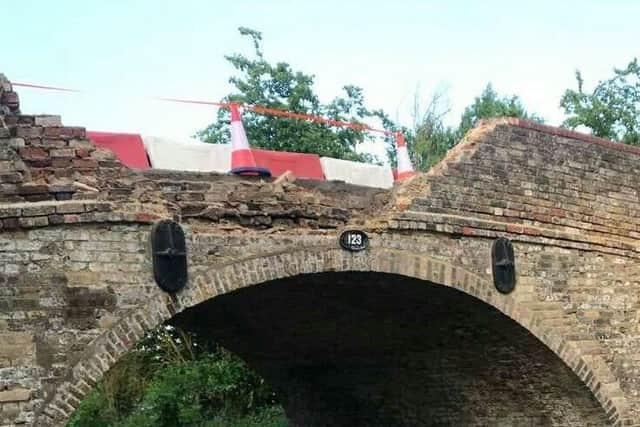‘Horton bridge weight restrictions will impact businesses and cause danger’
and live on Freeview channel 276
The bridge, which is located south of the village on the ‘B488’, is due to have a temporary weight limit of 18 tonnes MGW, which means lorries visiting local industrial estates will have to divert through villages, including Cheddington and Long Marston.
Linda White, regional operations manager of the Road Haulage Association (South East Region), said: “This will prevent LGV’s being able to access businesses, both adjacent to the bridge and 35 businesses at the nearby Cheddington Airfield.


Advertisement
Advertisement
“These SMEs all rely on LGVs to deliver and collect their products. The diversion will add extra costs - fuel, additonal hours. One business has calculated extra cost at £100K per annum, and more than 40 others will have similar costs.”
Fiona Hobbs, of JR Smith Transport, Leighton Buzzard and Tring, said: “I have personally offered to take out the council in an articulated lorry on the routes they are suggesting. I have been driving for years but would not feel comfortable driving through the narrow villages.
“There will be children dilly-dallying and coming out of school – someone is going to get killed or seriously injured.”
Mark Savage, regional manager of MGF Trench Construction Systems, based on the airfield, said: “We need a collaborative approach by all interested parties to reach an amicable solution.”
Advertisement
Advertisement
Businesses are hoping the restriction will only be a temporary solution and that the council will either repair it or construct a bailey bridge.
They were also disappointed that Bucks County Council did not attend a meeting held on February 12 at MGF with the owners of the industrial estate, operators, RHA members and local parish councillors.
Liz Frazier, owner of the Cheddington Airfield industrial estate, claimed: “It’s going to have a massive impact on the businesses down there. The diversion will cost so much money in fuel and drivers’ time.
“It’s also an accident waiting to happen - sometimes you can hardly get a car through Cheddington!
Advertisement
Advertisement
“I kept writing to Paul Irwin [Bucks County Council’s deputy cabinet member for transportation], and kept trying to phone him, but he didn’t respond.
“It seems as if the council has been trying to sweep it under the radar.
“Not even the parish councils knew about it until the meeting.”
Liz added: “If there has been a survey on the bridge we would like to have the report. Heavy machinery used to drive across during World War Two - surely, the bridge is adequate for purpose?”
Advertisement
Advertisement
Bucks County Council’s deputy cabinet member for transportation, Paul Irwin, said: “The facts are that Brownlow Bridge, which is owned by the Canal and River Trust, has been deemed unsafe for vehicles over 18 tonnes, which means we have to take action. We’ll be working with the local community to consider the range of options available to us.
“Last week [beginning Mon Feb 11, at the time of speaking], we received a letter from the solicitors representing the owners of the airfield and we will need to respond to that before anything else can progress.
“Although not yet in force, we are preparing to implement a weight limit as soon as possible to help protect the structure of the bridge.”
He added: “As highway authority, we are ultimately responsible for making sure we keep everyone safe on our roads, that’s our legal duty. Knowing that Brownlow Bridge has structural issues means we now have to take remedial action.
Advertisement
Advertisement
“There’s a lot to consider here due to the important route the bridge is on and I know rumours are already circulating locally which doesn’t help.
“We need to properly consider a range of options and my aim is to work with local people and businesses to make the right decisions in both the short and longer term. Indeed, we hope to be able to meet with the business park and local parish councils in March.”
A Canal & River Trust spokesperson, said: “The bridge was not designed and built for us by the multi-tonne trucks that currently use it, and now repeated use by these large and heavy vehicles has had impact.
“We’ve raised our concerns with the local authority who are responsible for the use of roads, they have recognised the problem and introduced temporary restrictions for vehicles over 18 tonnes (gross). We have been in touch with the local authority about the best possible long term solution.
Advertisement
Advertisement
“The Canal & River Trust does not have the jurisdiction to provide alternative routes. This would need to be considered by the local Highways Authority.
“The Highways Authority can either grant the PWR (Permanent Weight Restriction) to 18TGVW (tonne gross vehicle weight) or if they consider it necessary, upgrade the bridge to full strength to take 40TGVW (current estimation of usage). When applying for a Traffic Regulation Order to implement a weight restriction, the Highway Authority will look at alternative routes and the impact of the restriction to the local community.
“Canal & River Trust has a restricted liability for maintenance of our road bridges, which is limited to 9TA (tonne per axel) . The bridge meets Trust’s statutory obligations (under 1968 Transport Act), so the Trust has no obligations to strengthen the bridge. It would need to be funded by the Highways Authority.
“Weight Restriction Limit is in place to protect the structure over a longer period of time. The bridge is being constantly over loaded with heavy large vehicles causing constant damage to the bridge, which deteriorates the general condition of the bridge. Deterioration of arch bridges occurs over long periods of time. Applying a weight restriction limit will help to extend the life of the bridge.”